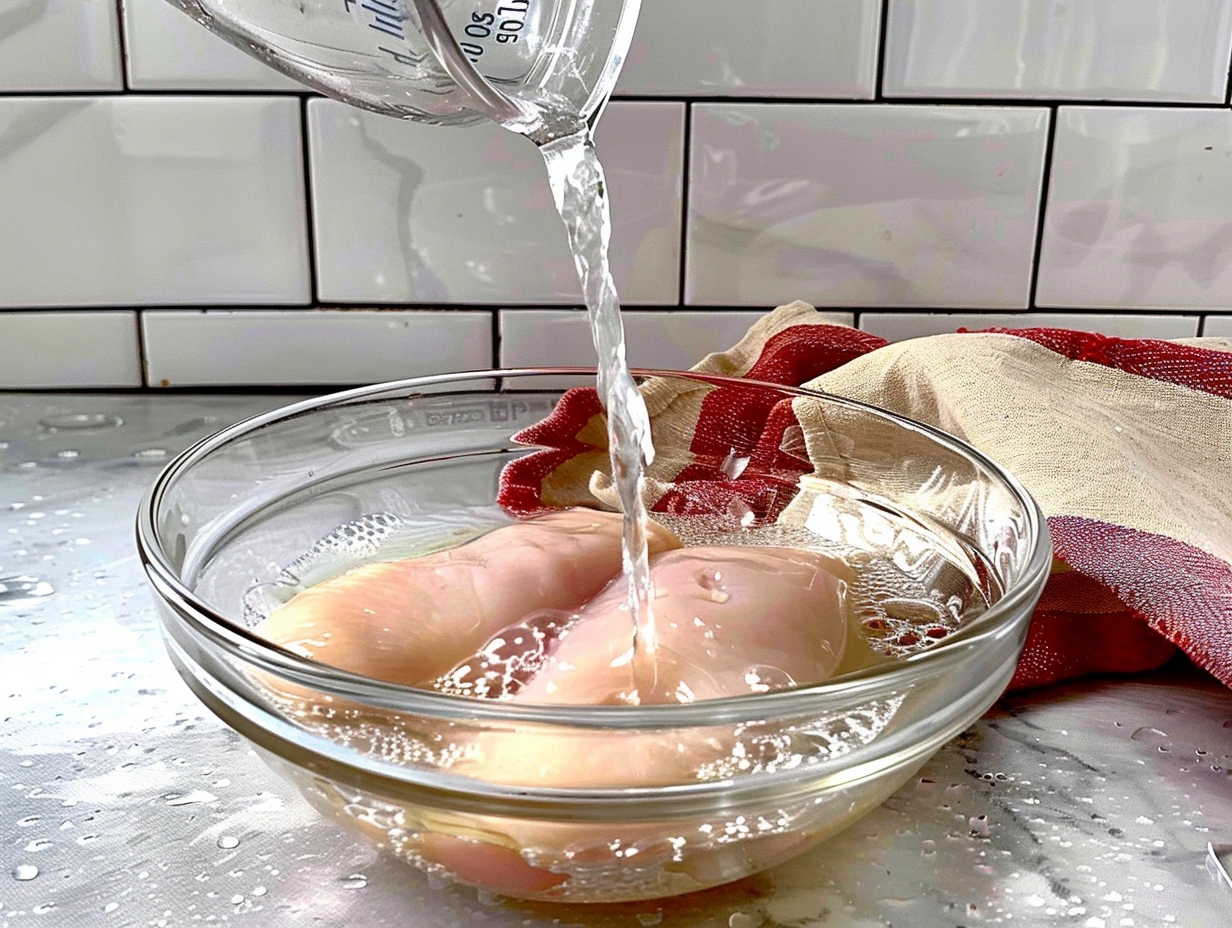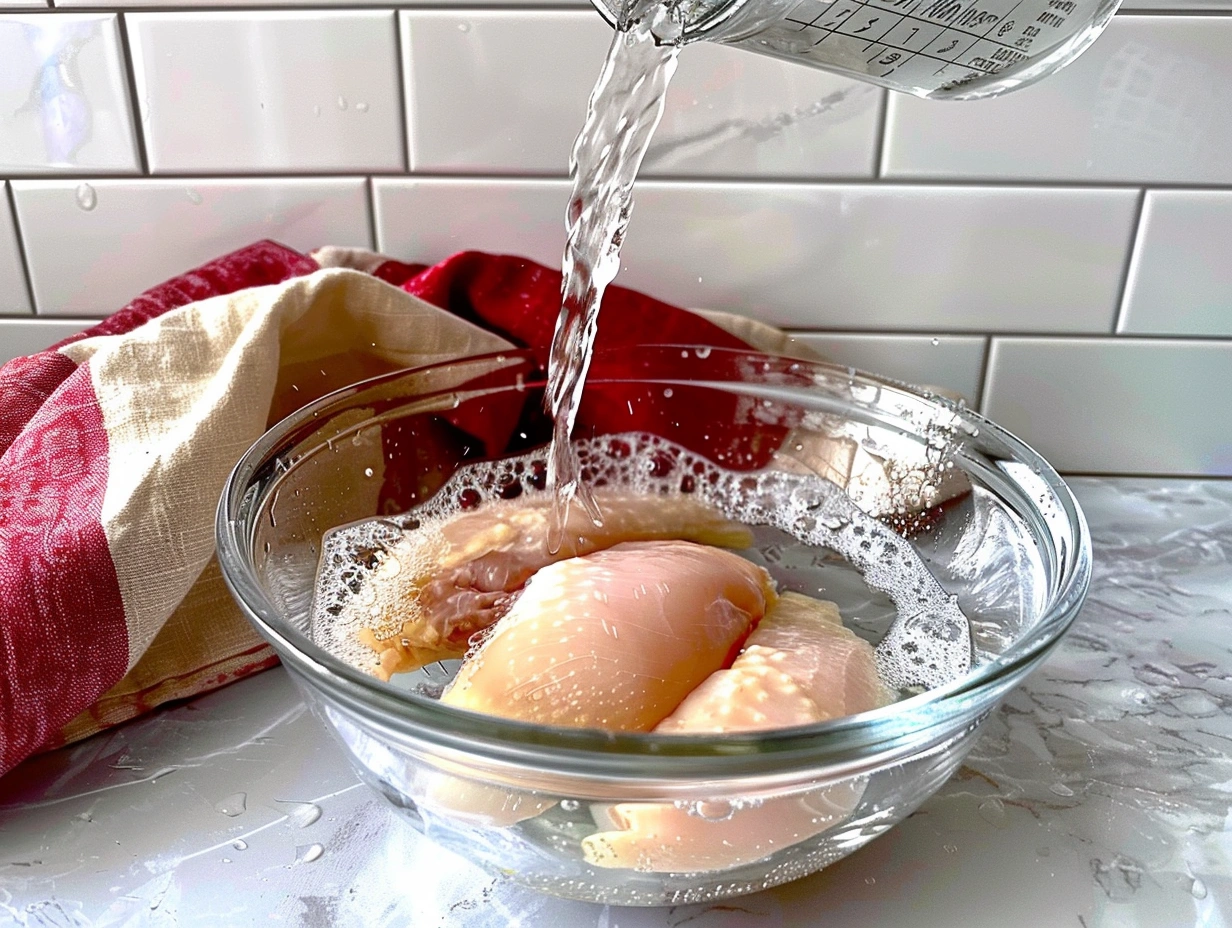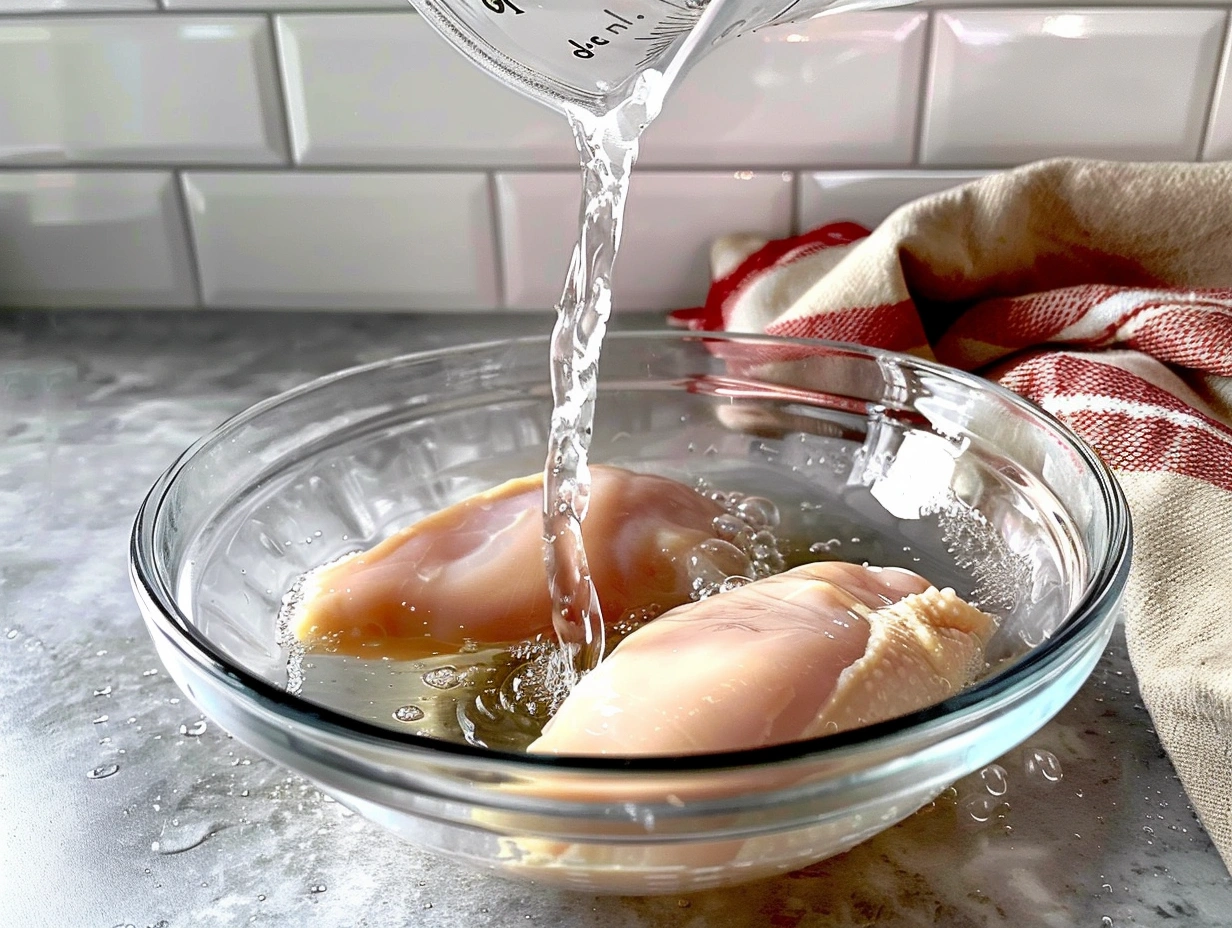Part 1: Introduction and Basics

1. Introduction to Brining
Brining is a simple but powerful technique for improving the flavor and texture of meat, seafood, and even vegetables. By soaking food in a mixture of salt and water, brining helps the food absorb moisture and seasonings, leading to more tender and flavorful dishes.
Brining is commonly used for meats such as chicken, turkey, and pork, but it’s also perfect for seafood like salmon and shrimp. The process helps prevent these foods from drying out during cooking, whether you’re grilling, roasting, or frying.
At its core, brining works through the scientific process of osmosis, where saltwater is absorbed into the food, and diffusion, which evenly distributes the salt and flavors throughout the meat.
2. What is the Basic Brine Formula?
A basic brine formula is simple and easy to follow. The most common ratio is:
- 1 gallon of water
- 1 cup of kosher salt
You can also add sugar (about ½ cup per gallon of water) if you want to balance the saltiness or create a sweeter brine. Additionally, herbs, spices, garlic, and citrus can be added to give the brine extra flavor.
The balance of ingredients in the brine is key. Too much salt can make the food overly salty, while too little may not provide enough moisture retention. The additional flavors, like herbs and spices, can be tailored to the dish you’re preparing, making it highly customizable.
For more detailed guidance on the salt-to-water ratio, visit this Salt to Water Ratio Guide.
3. Understanding Salt Concentration in Brine
The amount of salt in your brine depends on what you are brining and how long you plan to brine it. Different foods require varying concentrations of salt to achieve the best results.
Brining for Different Foods
- For Meat: A typical ratio is 1 cup of kosher salt per gallon of water. This works well for larger cuts like turkey, chicken, and pork. These meats tend to be lean and can dry out quickly if not brined properly. The salt helps them retain moisture and stay juicy during cooking.
- For Seafood: A lighter brine works best—try ½ cup of salt per gallon of water for fish and shrimp. Seafood is much more delicate than meat and doesn’t require as much salt or time in the brine. Over-brining can easily lead to an overly salty or tough texture, which ruins the delicate nature of the seafood.
- For Vegetables: A weaker solution is ideal, such as ¼ cup of salt per gallon of water. Vegetables like cucumbers, carrots, or green beans are typically brined for pickling. The brine not only preserves them but also adds flavor and enhances the texture. Adding herbs like dill or spices like mustard seeds is common for a flavorful vegetable brine.
Types of Salt for Brining
The type of salt you use matters, too. Kosher salt is the most popular choice because of its coarse grains, which dissolve more evenly in the brine. Its larger granules provide a consistent salting process without overwhelming the food. Sea salt can also be used but tends to be more expensive. It also contains trace minerals, which may slightly alter the flavor, although the effect is usually subtle. Table salt should be avoided because it’s much finer and can lead to overly salty brines, especially since most table salts contain iodine, which can add an off-flavor.
Effects of Salt Concentration
The salt concentration in a brine affects not only the flavor but also the texture of the food. Too much salt can draw out too much moisture, leading to a dry or overly salty final product. On the other hand, too little salt won’t allow enough water retention, and the food may still dry out during cooking. Additionally, the salt breaks down the proteins in meat, making it more tender. This process is particularly beneficial for tougher cuts like pork or beef.
Part 2: Types of Brine and How to Customize

4. Wet Brine vs. Dry Brine
When it comes to brining, there are two primary methods: wet brining and dry brining. Each has its benefits and drawbacks, and the method you choose depends on what you are cooking and how you plan to cook it.
Wet Brine
A wet brine involves completely submerging the food in a saltwater solution. This method is excellent for larger cuts of meat, such as whole chickens, turkeys, or pork loins. The primary benefit of wet brining is that it adds moisture to the food, making it ideal for lean meats that tend to dry out during cooking. The saltwater solution penetrates the meat, not only seasoning it but also ensuring that the moisture is retained during high-heat cooking methods like roasting or grilling.
Advantages of Wet Brining:
- Adds significant moisture to lean cuts, preventing them from drying out.
- The liquid helps distribute any additional flavors, like herbs or spices, evenly throughout the meat.
- Ideal for roasting or smoking larger cuts of meat, where the cooking time is longer.
Disadvantages of Wet Brining:
- Requires a large container and enough liquid to fully submerge the food.
- Takes up significant space in the refrigerator.
- Can lead to soggy skin if not properly dried before cooking.
Dry Brine
A dry brine involves rubbing the food with salt (and sometimes other seasonings) and letting it sit uncovered in the refrigerator. The salt draws moisture out of the food initially, but over time, that moisture is reabsorbed along with the salt and seasonings. This method is faster and requires less space than wet brining. It also helps create a crispy skin when roasting or grilling, making it the preferred method for dishes like fried chicken or grilled meats.
Advantages of Dry Brining:
- Easier to apply and doesn’t require as much space as wet brining.
- Results in crispier skin, especially when grilling or frying.
- Ideal for smaller cuts or when you need a quicker method of brining.
Disadvantages of Dry Brining:
- Doesn’t add as much moisture as wet brining, so it may not be as suitable for very lean cuts.
- Doesn’t work as well for longer cooking times like smoking or slow roasting.
If you’re looking for a quick and flavorful chicken recipe, check out this Easy Bibibop Copycat Chicken Recipe to try after brining your chicken.
5. Customizing Your Brine
One of the great advantages of brining is how easy it is to customize the brine to suit your taste and the dish you’re preparing. Beyond the basic salt and water formula, there are many ways to adjust the flavor of your brine to match the recipe or your personal preferences.
Adding Herbs and Spices
- Herbs: Fresh herbs such as rosemary, thyme, parsley, and sage can give your brine a fresh, aromatic quality. These herbs pair particularly well with poultry and pork, adding depth of flavor that complements the saltiness of the brine.
- Garlic: Adding crushed garlic to the brine gives a rich, savory flavor to the meat. This works especially well with chicken and pork.
- Peppercorns: Black peppercorns are often added to brines for a subtle heat that balances out the saltiness. You can also use red or white peppercorns for a slightly different flavor profile.
Sweeteners to Balance Saltiness
Adding a sweetener to your brine is a great way to balance the saltiness and add complexity to the final dish. Common sweeteners include:
- Sugar: Brown sugar or white sugar can be added to the brine to give a slight sweetness. This is particularly effective when brining pork or turkey, where the sweetness balances the natural flavors of the meat.
- Honey: Honey adds both sweetness and moisture to the brine. It pairs well with poultry and helps to create a golden, caramelized finish when roasting.
- Molasses: Molasses can be used in place of sugar for a more complex, slightly bitter sweetness.
Making a Spicy Brine
If you prefer a bit of heat, it’s easy to turn your brine into a spicy one by adding ingredients like:
- Chili flakes for a subtle, slow-building heat.
- Cayenne pepper or paprika for a smoky, intense spiciness.
- Fresh jalapeños or serrano peppers for a bright, sharp heat.
For more ideas on how to enhance the flavor of brined chicken, explore this Ultimate Guide to Chicken Brine to see different variations you can use.
6. Common Brine Recipes for Various Foods
There is no one-size-fits-all brine recipe. The type of brine you use should depend on the type of food you’re preparing. Here are some common brine recipes based on food types:
Meat Brine
For chicken, turkey, or pork, the standard brine formula works best: 1 gallon of water, 1 cup of kosher salt, and ½ cup of sugar. Additional ingredients like herbs, garlic, and peppercorns can be added based on your taste preferences. Brining these meats helps them retain moisture during longer cooking processes like roasting or grilling.
Seafood Brine
Seafood, such as salmon, shrimp, or crab, requires a lighter brine. Use ½ cup of kosher salt per gallon of water. You can also add fresh citrus slices, dill, and bay leaves to the brine for a fresh, clean flavor. Seafood doesn’t require a long brining time; a short soak of 30 minutes to 1 hour is usually sufficient.
Vegetable Brine
When pickling vegetables like cucumbers or carrots, a weaker brine is used to preserve their texture and flavor. Try ¼ cup of kosher salt and 2 tablespoons of sugar per gallon of water. Add herbs like dill and spices like mustard seeds or peppercorns to create a classic pickling flavor.
Once you’ve mastered the basic brine, try out this Arlington Chicken Salad Recipe for a delicious meal that uses brined chicken.
7. How Long to Brine Different Foods
The amount of time you brine food depends on both the type of food and its size. Here’s a more detailed breakdown:
Meat
- Whole Chicken or Turkey: For larger cuts, brining should last between 12-24 hours. The longer brining time ensures that the salt has time to penetrate the thickest parts of the meat, particularly the breast.
- Chicken Breasts or Wings: Smaller cuts of meat, like chicken breasts or wings, should be brined for 4-6 hours. This allows enough time for the meat to absorb moisture and flavor without becoming overly salty.
- Pork Chops: Pork chops require 4-8 hours of brining. For thicker chops, aim for the higher end of this range to ensure that the interior stays juicy and flavorful.
Seafood
- Shrimp or Salmon: Since seafood is more delicate, it requires less time in the brine. Brine shrimp or salmon for 30 minutes to 1 hour. Any longer than that, and the fish will become too salty or tough.
Vegetables
- Vegetables for Pickling: Vegetables like cucumbers, carrots, or green beans can be brined for 12-24 hours. The brine both preserves the vegetables and infuses them with flavor.
What Happens if You Brine for Too Long?
If you brine food for too long, the texture can become mushy, and the flavor overly salty. This is particularly problematic with delicate items like seafood or smaller cuts of meat. If this happens, you can soak the food in fresh water for 30 minutes to draw out some of the excess salt.
Part 3: Techniques, Troubleshooting, and Safety

8. The Science Behind Brining
Brining is effective due to two scientific processes: osmosis and diffusion. These processes work together to enhance the moisture content and flavor of the food.
Osmosis: Retaining Moisture
Osmosis is the movement of water through a membrane (in this case, the meat’s muscle fibers) from an area of low salt concentration to an area of high salt concentration. When food is placed in a saltwater brine, water is drawn into the meat. This extra moisture is crucial for preventing the food from drying out during cooking, especially when using high-heat methods like grilling or roasting.
Diffusion: Infusing Flavor
As the salt moves into the meat, it also carries with it any seasonings or flavors added to the brine. This is known as diffusion. Over time, the flavors of the brine—whether it’s garlic, herbs, or spices—penetrate deep into the meat, making every bite flavorful.
The Role of Salt in Breaking Down Proteins
Salt doesn’t just help retain moisture; it also breaks down the protein structures in the meat. When the proteins break down, they create a more tender texture, which is why brined meats often taste softer and more tender than unbrined ones.
9. Common Mistakes and How to Fix Them
Brining may seem straightforward, but there are several common mistakes that can ruin your dish. Here’s how to avoid them:
Using Too Much Salt
One of the most common mistakes in brining is using too much salt. If the brine is too salty, the food will absorb more salt than necessary, resulting in an overly salty final dish. To fix an overly salty brine, you can either dilute it with more water or reduce the brining time to prevent too much salt absorption.
Over-Brining
Over-brining happens when food is left in the brine for too long. The result is mushy, overly salty food. If you’ve accidentally left your food in the brine for too long, you can soak it in fresh water for 30 minutes to reduce the saltiness and restore some of the original texture.
Not Rinsing the Meat
After brining, it’s essential to rinse the meat under cold water to remove any excess salt on the surface. If you skip this step, your dish may turn out much saltier than intended. Always pat the meat dry after rinsing to ensure it browns properly when cooked.
10. Food Safety and Storage Considerations
When brining, food safety should be a top priority. Here are some essential tips to keep in mind:
Safe Storage
Always store brining food in the refrigerator. Leaving it at room temperature can lead to bacterial growth, which can cause foodborne illnesses. Make sure the food is fully submerged in the brine and that the container is covered to prevent cross-contamination.
Avoiding Cross-Contamination
When brining raw meat, it’s important to keep it separate from other foods. Always wash your hands and any utensils or surfaces that come into contact with raw meat. Use a separate container for brining different types of food to avoid cross-contamination.
Proper Rinsing
Once the brining process is complete, always rinse the food under cold water to remove excess salt. Pat the food dry with paper towels before cooking to ensure a crispy exterior, especially for roasted or grilled dishes.
Part 4: FAQs and Additional Tips
11. FAQs About Brining
- How much salt should you use in a brine?
The standard ratio is 1 cup of salt per gallon of water. However, this can vary based on the food you’re brining and your taste preferences. - Can you brine meat for too long?
Yes, over-brining can result in overly salty and mushy textures. It’s essential to follow the recommended brining times for each type of food to avoid this. - What is the best type of salt to use for brining?
Kosher salt is preferred for brining because its coarse grains dissolve more evenly and slowly than fine table salt. - What happens if you don’t rinse meat after brining?
Failing to rinse the meat after brining can leave excess salt on the surface, leading to an overly salty final product. - Can you reuse brine?
No, it’s not recommended to reuse brine, especially if it has been used for raw meat, as this can lead to bacterial contamination.
12. Conclusion: Perfecting Your Brine Formula
Brining is a simple but highly effective way to make sure your meat, seafood, or vegetables stay juicy and flavorful. Whether you’re using a basic salt and water brine or customizing it with herbs and spices, the process can dramatically improve the texture and taste of your food. Experiment with different ingredients and brining times to create your perfect brine formula, and enjoy consistently delicious results every time!